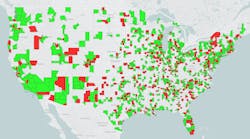The electric utility market doesn’t always represent a big chunk of the typical electrical distributors business, and Electrical Wholesaling data shows that utility products represent 7.3% of all electrical products sold through distributors. But some distributors focus on it in a much bigger way, such as WESCO, Graybar, Border States Electric, Sonepar (through its Irby business unit) as well as the utility specialists like Tri-State Utility Products and other members of the North American Association of Utility Distributors (NAAUD).
For these companies, one of the biggest trends in the utility market over the past few years — the construction of dozens of natural gas-fired generating facilities — may represent additional sales. As coal-fired power plants are retired because of environmental concerns, utilities are taking advantage of low-cost natural gas to build “peaker plants,” which supplement the power generation of a power plant when demand is high. In some instances, natural gas plants also provide base load generation. According to data from the Energy Information Administration (EIA), well over 100 natural gas-fired generating facilities are either under construction or in some stage of the regulatory process. The table below offers a status report on these facilities.
According to a post at www.eia.gov, “In its latest Short-Term Energy Outlook, EIA forecasts that natural gas-fired electricity generation in the United States will increase by 6% in 2019 and by 2% in 2020. EIA also forecasts that generation from wind power will increase by 6% in 2019 and by 14% in 2020. These trends vary widely among the regions of the country. Growth in natural gas generation is highest in the Mid-Atlantic region, and growth in wind generation is highest in Texas. EIA expects coal-fired electricity generation to decline nationwide, falling by 15% in 2019 and by 9% in 2020.”
The longer-term outlook for future construction of these facilities is uncertain because of concerns over the greenhouse gases they emit during operation and because of environmental concerns over the natural gas production process. In addition, some energy industry analysts consider natural gas to be a transitional generation technology that won’t account for as high a percentage of future total U.S. power production as solar, wind and other renewable technologies become more cost-competitive for utility-scale generation.









